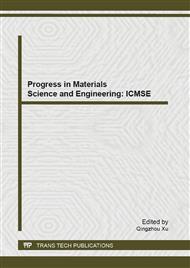[1]
V. G. Veselago, Sov. Phys. Usp. 10 (1968) 509.
Google Scholar
[2]
D. R. Smith, W. J. Padilla, D. C. Vier, S. C. Nemat-Nasser, and S. Schultz, Phys. Rev. Lett. 84 (2000) 4184.
Google Scholar
[3]
N. Fang, H. Lee, C. Sun, and X. Zhang. Science 308 (2005) 5721.
Google Scholar
[4]
T. Xu, Y. Zhao, J. Ma, C. Wang, J. Cui, C. Du, and X. Luo, Opt. Express 16 (2008) 13579.
Google Scholar
[5]
H. S. Chen, L.X. Ran, F.J.T. Huang, X. Zhang, K. Chen, T.M. Grzegorczyk, J.A. Kong, Appl. Phys. Lett. 86 (2005) 151909.
Google Scholar
[6]
J. H. Lv, X.W. Hu, M.H. Liu, B. R. Yan, L.H. Kong, J. Opt. A, Pure Appl. Opt. 11, 085101 (2009).
Google Scholar
[7]
X. Zhou, X. P. Zhao, Appl. Phys. Lett. 91 (2007) 181908.
Google Scholar
[8]
H. Chen, L. Ran, J. Huangfu, X. Zhang, K. Chen, T. M. Grzegorczyk, and J. A. Kong, Phys. Rev. E 70 (2004) 057605.
Google Scholar
[9]
G. Dolling, C. Enkrich, M. Wegener, J. F. Zhou, C. M. Soukoulis, and S. Linden, Opt. lett. 30 (2005) 3198.
DOI: 10.1364/ol.30.003198
Google Scholar
[10]
T. Kaelberer, V. A. Fedotov, N. Papasimakis, D. P. Tsai, N. I. Zheludev, Science 330 (2010) 1510.
DOI: 10.1126/science.1197172
Google Scholar
[11]
M. Kafesaki, I. Tsiapa, N. Katsarakis, T. Koschny, C. M. Soukoulis, and E. N. Economou, Phys. Rev. B 75 (2007) 235114.
DOI: 10.1103/physrevb.75.235114
Google Scholar
[12]
J. H. Lv, B. R. Yan, M. H. Liu, and X. W. Hu. Phys. Rev. E 80 (2009) 026605.
Google Scholar
[13]
J. F. Wang, S. B. Qu, Z. Xu, J. Q. Zhang, H. Ma, Y. M. Yang, and C. Gu. Photon. Nanostruct. Fundam. Appl. 7 (2009) 108.
Google Scholar
[14]
J. Q. Gu, J. G. Han, X. C. Lu, R. Singh, Z. Tian, Q. R. Xing, and W. L. Zhang. Optics Express 17, (2009) 20307.
Google Scholar
[15]
Hao, Z., M. C. Martin, B. Harteneck, S. Cabrini, and E. H. Anderson. Appl. Phys. Lett. 91(2007) 253119.
Google Scholar
[16]
P. Ding, E. J. Liang, L. Zhang, Q. Zhou, and Y. X. Yuan. Phys. Rev. E 79 (2009) 016604.
Google Scholar
[17]
Z. G. Dong, M. X. Xu, S. Y. Lei, H. Liu, T. Li, F. M. Wang, and S. N. Zhu, Appl. Phys. Lett. 92(2008) 064101.
Google Scholar
[18]
A. N. Grigorenko, A. K. Geim, H. F. Gleeson, Y. Zhang, A. A. Firsov, I. Y. Khrushchev, and J. Petrovic. Nature. 438 (2005) 335.
DOI: 10.1038/nature04242
Google Scholar
[19]
N. T. Tung, V. D. Lam, J. W. Park, M. H. Cho, Y. P. Lee, J. Y. Rhee, and W. H. Jang, J. Appl. Phys. 106 (2009) 053109.
Google Scholar
[20]
N. T. Tung, V. T. T. Thuy, J. W. Park, J. Y. Rhee, and Y. R. Lee, J. Appl. Phys. 107 (2010)023530.
Google Scholar
[21]
Z. G. Dong, S. N. Zhu, H. Liu, J. Zhu, W. Cao, Phys. Rev. E 72 (2005) 016607.
Google Scholar
[22]
L. X. Ran, J. Huang Fu, H. S. Chen, X. M. Zhang, K. S. Chen, J. Appl. Phys. 95 (2004) 2238.
Google Scholar


